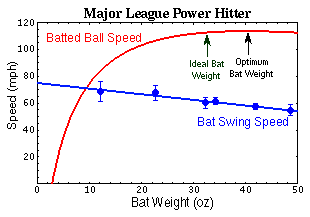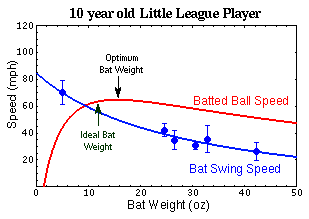Bat Weight, Swing Speed, and Batted Ball Velocity
By:
Anyone who has swung a bat knows that it is easier to swing a lighter bat than it is to swing a heavier bat. More importantly, it is possible to swing a lighter bat faster than a heavier bat. Exactly how the bat swing speed is related to bat weight for a given player is a little harder to determine. Terry Bahill[2,7,8] and his colleague have extensively studied the relationship between bat swing speeds and bat weights for a wide variety of players. Bahill developed the Bat ChooserTM machine to measure bat swing speed, and uses the results to determine the Ideal Bat WeightTM for an individual player. This device has been successfully used by numerous players who have greatly increased their batting averages after correctly choosing an appropriate weight bat, as well as by several college teams who have gone on to win championships after finding their correct bat weights. His data shows definitively that players cannot swing heavy bats as quickly as they can lighter bats, and the details vary somewhat from player to player and vary more considerably depending on the technical playing ability of the individual. For example, using results from his published work[7,8] measurements of the bat speed a function of bat weight for a Major League power hitter as may be fit by the straight line equation
v2b= - 0.42 m2 + 75 (power hitter)
where speed is in mph and weight is in ounces.
In contrast, measurements for a 10 year old Little League player were better
fit by a hyperbola
(m2 + 28)(v2b+12.8) = 2728. (little leaguer)
Let's assume that the mass of the baseball is a constant m1=5.125oz, the coefficient of restitution is e=0.55, and that the initial velocity of the baseball is representative of a typical pitch speed, (v1b=-90mph for the Major League player and v1b=-40mph for the Little League player). Then we can substitute either of the equations for bat speed into the equation for batted ball speed and make some plots like those shown by Bahill in his papers[2,7] and book[8]. The blue dots with error bars represent measurements of bat swing speed for various bat weights. The blue curve in each plot shows how the bat swing speed decreases with increasing bat weight according to the equations above. The red curve in each plot shows how the resulting batted ball velocity depends on both the bat weight and the bat swing speed. Notice that the curves are very different for the Major League power hitter and the Little League. The professional has much more control over his bat swing speed, and can produce much greater final ball speed.


Both plots show that the batted ball velocity initially increases as the bat weight increases until the bat swing speed drops below a certain level after which the batted velocity begins to decrease again. This results in an "optimum" bat weight for each player, indicated by the black arrows in the plots. This optimum bat weight is the bat weight which will result in the fasted batted ball velocity for each player. The optimum bat weight for the professional power hitter is about 41oz, and about 16oz for the Little Leaguer.
Perhaps a pertinent question is why a major league power hitter would choose to use a lighter bat (say 32oz) when an optimal 41oz bat would produce a higher batted ball velocity? Two possibilities come to mind. First, the fact that you can swing a lighter bat faster means that you can wait just a little bit longer before committing to a swing. For a professional, the ability to wait even 1/10th of a second longer to watch a pitched ball can result in a considerable improvement in the chance of making contact. Secondly, most hitters can control a lighter bat more effectively than they can a heavier bat. Bat control affects the location of the bat as it crosses the plate, and more control over bat location is definitely a good thing when the pitched ball crosses the plate considerable variation in height or distance from the batter. Notice further, from the plot for the major league power hitter, that for bat weights in the range of 35oz to 45oz there is very minor change in the batted ball velocity. Using a 33oz bat instead of a 41oz bat will only very slightly reduce the batted ball velocity, but it will have a significant affect on the bat swing speed and the resulting swing time. Based on such a trade-off between ball speed and bat control, Bahill has defined the Ideal Bat WeightTM as the weight at which the batted ball speed drops 1% below the speed of the optimum batted ball speed bat weight. As shown in the plot, the Ideal Bat Weight for the power hitter is about 32-33oz. This is right in the weight range used by most professional players.
The results for the Little League player are quite different. The optimum bat weight, for maximum batted ball speed, is about 16oz, and the Ideal Bat Weight is about 12-13oz. As was shown in the table at the top of this page, most available 30-inch wood and aluminum Little League bats weigh between 20 and 26oz, which is well above both the optimum and ideal weights for this player. From the plot we can see that if this player used a 23oz bat he would have a much lower bat swing speed and a significantly lower batted ball velocity. Most young players are forced to use bats which are heavier than the ideal bat weight because light enough bats are not available. Only this year (2003) have composite bats become available that begin to approach 16oz for a 30-inch bat.
